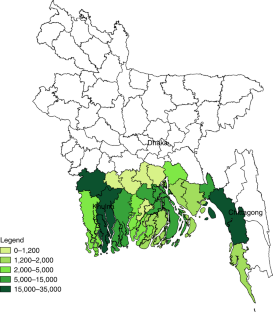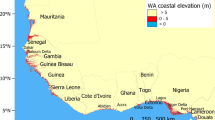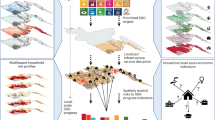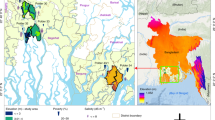Abstract
Climate change is not only altering weather patterns but also accelerating sea-level rise, leading to increased inundation and saline contamination of soils. Given projected sea-level rise, it is imperative to examine the extent to which farmers in coastal Bangladesh can adapt by diversifying economic activities before resorting to migration within and across borders. Here, to identify patterns in how households adapt to increased sea/freshwater flooding and soil salinity, we analyse nationally representative socioeconomic and migration data against a suite of environmental variables constructed at the sub-district level. Our results show that inundation alone has negligible effects on migration and agricultural production. However, gradual increases in soil salinity correspond to increasing diversification into aquaculture and internal migration of household members. Salinity is also found to have direct effects on internal and international migration even after controlling for income losses, with mobility restricted to certain locations within Bangladesh. Our study suggests that migration is driven, in part, by the adverse consequences of salinity on crop production.
This is a preview of subscription content, access via your institution
Access options
Access Nature and 54 other Nature Portfolio journals
Get Nature+, our best-value online-access subscription
$29.99 / 30 days
cancel any time
Subscribe to this journal
Receive 12 print issues and online access
$209.00 per year
only $17.42 per issue
Buy this article
- Purchase on Springer Link
- Instant access to full article PDF
Prices may be subject to local taxes which are calculated during checkout


Similar content being viewed by others
Data availability
The datasets generated during the current study and Stata dofiles utilized in the analysis are available upon request from the corresponding authors.
References
Clark, P. et al. Consequences of twenty-first-century policy for multi-milliennial climate and sea-level change. Nat. Clim. Change 6, 360–369 (2016).
Yu, W. H. et al. Climate Change Risks and Food Security in Bangladesh (Earthscan, Washington DC, 2010).
Gray, C. & Mueller, V. Natural disasters and population mobility in Bangladesh. Proc. Natl Acad. Sci. USA 109(16), 6000–6005 (2012).
Lu, X. et al. Unveiling hidden migration and mobility patterns in climate stress regions: a longitudinal study of six million anonymous mobile phone users in Bangladesh. Glob. Environ. Change 38, 1–7 (2016).
Call, M., Gray, C., Yunus, M. & Emch, M. Disruption, not displacement: environmental variability and temporary migration in Bangladesh. Glob. Environ. Change 46, 157–165 (2017).
Chen, J. J., Mueller, V., Jia, Y. & Tseng, S. K.-H. Validating migration responses to flooding using satellite and vital registration data. Am. Econ. Rev. 107, 441–445 (2017).
Banerjee, L. Effects of flood on agricultural productivity in Bangladesh. Oxf. Dev. Stud. 38, 339–356 (2010).
Alauddin, M. & Sharma, B. R. Inter-district rice water productivity differences in Bangladesh: an empirical exploration and implications. Ecol. Econ. 93, 210–218 (2013).
Alauddin, M., Amarasinghe, U. & Sharma, B. Four decades of rice water productivity in Bangladesh: a spatio-temporal analysis of district level panel data. Econ. Anal. Policy 44, 51–64 (2014).
Alpuerto, V.-L. E. B., Norton, G. W., Alwang, J. & Ismail, A. M. Economic impact analysis of marker-assisted breeding for tolerance to salinity and phosphorous deficiency in rice. Appl. Econ. Perspect. Policy 31, 779–792 (2009).
Hauer, M. E. Migration induced by sea-level rise could reshape the US population landscape. Nat. Clim. Change 7, 321–325 (2017).
Fussell, E. Oxford Handbook of the Politics of International Migration (eds Rosenblum, M. R. & Tichenor, D. J.) Ch. 1 (Oxford Univ. Press, New York, 2012).
Feng, S., Krueger, A. B. & Oppenheimer, M. Linkages among climate change, crop yields and Mexico–US cross-border migration. Proc. Natl Acad. Sci. USA 107, 14257–14262 (2010).
Cai, R., Feng, S., Oppenheimer, M. & Pytlikova, M. Climate variability and international migration: the importance of the agricultural linkage. J. Environ. Econ. Manage. 79, 135–151 (2016).
Cattaneo, C. & Peri, G. The migration response to increasing temperatures. J. Dev. Econ. 122, 127–146 (2016).
Xu, H. Modification of normalized difference water index (NDWI) to enhance open water features in remotely sensed imagery. Int. J. Remote Sens. 27, 3025–3033 (2006).
Ji, L., Zhang, L. & Wylie, B. Analysis of dynamic thresholds for the normalized difference water index. Photogramm. Eng. Remote Sensing 75, 1307–1317 (2009).
Ogilvie, A. et al. Decadal monitoring of the Niger inner delta flood dynamics using MODIS optical data. J. Hydrol. (Amst.) 523, 368–383 (2015).
Saline Soils of Bangladesh (Soil Resource Development Institute, 2012).
Welch, J. et al. Rice yields in tropical/subtropical Asia exhibit large but opposing sensitivities to minimum and maximum temperatures. Proc. Natl Acad. Sci. USA 107, 14562–14567 (2010).
Dodd, I. & Perez-Alfocea, F. Microbial amelioration of crop salinity stress. J. Exp. Bot. 63, 3415–3428 (2012).
Yan, N., Marschner, P., Cao, W., Zuo, C. & Qin, W. Influence of salinity and water content on soil microorganisms. Int. Soil Water Conserv. Res. 3, 316–323 (2015).
Azad, A. K., Jensen, K. R. & Lin, C. K. Coastal aquaculture development in Bangladesh: unsustainable and sustainable experiences. Environ. Manage. 44, 800–809 (2009).
Higgins, S. A. et al. InSAR measurements of compaction and subsidence in the Ganges-Brahmaputra Delta, Bangladesh. J. Geophys. Res. Earth Surf. 119, 1768–1781 (2014).
Black, R., Bennett, S. R., Thomas, S. M. & Beddington, J. Migration as adaptation. Nature 478, 447–449 (2011).
Islam, A. S., Bala, S. K. & Haque, M. A. Flood inundation map of Bangladesh using MODIS time-series images. J. Flood Risk Manag. 3, 210–222 (2010).
National Research Council NOAA’s Role in Space-Based Global Precipitation Estimation and Application (National Academies, Washington DC, 2007).
Tarek, M., Hassan, A., Bhattacharjee, J., Choudhury, S. & Badruzzaman, A. Assessment of TRMM data for precipitation measurement in Bangladesh. Meteorol. Appl. 24, 349–359 (2017).
Rosenzweig, M. R. & Binswanger, H. P. Wealth, weather risk and the composition and profitability of agricultural investments. Econ. J. (Lond.) 103, 56–78 (1993).
Ahmed, R. & Karmakar, S. Arrival and withdrawal dates of the summer monsoon in Bangladesh. Int. J. Climatol. 13, 727–740 (1993).
Acknowledgements
We thank K. Dotzel, Y. Jia, M. Kedir and S. Vallury for research assistance and S. K.-H. Tseng for sharing his code; C. Kinnan and participants of the National Socio-Environmental Synthesis Center (SESYNC) Pursuit Working Group on ‘A Forecast of the Timing, Locations, Sequence and Likeliest Destinations of Populations Displaced by Sea Level Rise and Coastal Extremes’ for providing constructive feedback on earlier versions of the manuscript. Financial support from the National Science Foundation via the Belmont Forum/IGFA Program (ICER-1342644) and the SESYNC Pursuit programme is acknowledged.
Author information
Authors and Affiliations
Contributions
J.C. and V.M. designed the evaluation, constructed the datasets and wrote the paper. J.C conducted the migration and livelihood impact analysis, while V.M. contributed the visual projections based on the migration modelling.
Corresponding authors
Ethics declarations
Competing interests
The authors declare no competing interests.
Additional information
Publisher's note: Springer Nature remains neutral with regard to jurisdictional claims in published maps and institutional affiliations.
Supplementary information
Supplementary Information
Supplementary Tables 1–5
Rights and permissions
About this article
Cite this article
Chen, J., Mueller, V. Coastal climate change, soil salinity and human migration in Bangladesh. Nature Clim Change 8, 981–985 (2018). https://doi.org/10.1038/s41558-018-0313-8
Received:
Accepted:
Published:
Issue Date:
DOI: https://doi.org/10.1038/s41558-018-0313-8
This article is cited by
-
Climate threats to coastal infrastructure and sustainable development outcomes
Nature Climate Change (2024)
-
The links between climate change and migration: a review of South Asian experiences
SN Social Sciences (2024)
-
SDG 12 needs an oceanic interface: sand mining, saltwater intrusion (SWI) and coastal sustainability
Sustainable Earth Reviews (2023)
-
Social vulnerability, impacts and adaptations strategies in the face of natural hazards: insight from riverine islands of Bangladesh
BMC Public Health (2023)
-
Exploring spatial feedbacks between adaptation policies and internal migration patterns due to sea-level rise
Nature Communications (2023)



